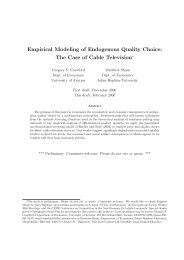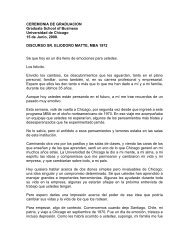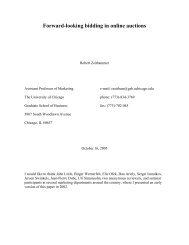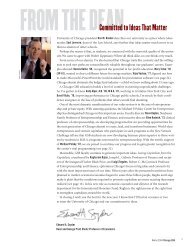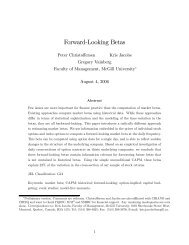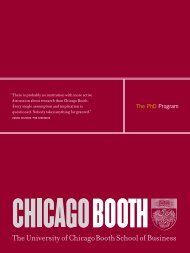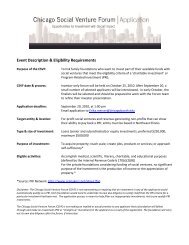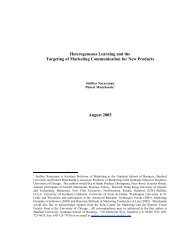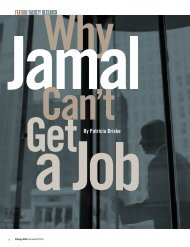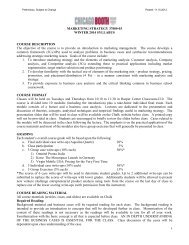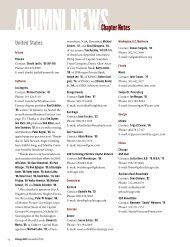D R A F T - The University of Chicago Booth School of Business
D R A F T - The University of Chicago Booth School of Business
D R A F T - The University of Chicago Booth School of Business
Create successful ePaper yourself
Turn your PDF publications into a flip-book with our unique Google optimized e-Paper software.
Preliminary, Subject to Change Posted: 11.25.2013Preliminary Version: 12/1/13 (Please disregard the earlier version that was posted) Objectives <strong>Business</strong> Policy (Sub-‐Titles: Strategies for Individuals and <strong>The</strong>ir Organizations; <strong>The</strong> Compleat Strategist) Winter 2014 42002-‐81: Tuesday, 6:00 -‐ 9:00 42002-‐01: Wednesday, 1:30 -‐ 4:30 People and business organizations must inevitably deal with the challenge <strong>of</strong> problem setting, namely defining the key issues for survival, growth and meaning. <strong>The</strong>se issues are <strong>of</strong>ten not well formed and appear as both messy and ambiguous. <strong>The</strong> work <strong>of</strong> problem setting takes place at boundaries between the present and future, between decision-‐making and action, and between the individual actor and the external environment. This course will strengthen your performance in these areas by providing vocabulary, skills, tools and insights that will help you undertake strategic analyses and actions in business and in your personal life. By the end <strong>of</strong> this course you will be more: • Comfortable working in strategy space • Discriminating in knowing when the specialized knowledge and techniques that form much <strong>of</strong> the MBA curriculum are useful, and when they are not • Open to deploying analytic, artistic and pragmatic thinking given the context and opportunity • Excited about your own pr<strong>of</strong>essional and personal strategy
Preliminary, Subject to Change Posted: 11.25.2013Implementation <strong>The</strong>re is no simple list <strong>of</strong> rules or principles that define the "right" issues or that will guarantee a “good” outcome if followed mechanically. Effective leadership at a personal and organizational level involves looking at a goal or challenge from a variety <strong>of</strong> different perspectives, both analytical and creative. This course is structured with that philosophy in mind. Among other things, the course is an invitation and an opportunity for personal and collective experimentation. Your participation is needed at several levels—the head, the heart and the hands—corresponding to my belief that the task <strong>of</strong> the general manager involves thinking, feeling and doing. My role is to help you penetrate what is in essence an open-‐ended and enjoyable activity. Faculty Harry L. Davis Harper Center, 346 VM: 773-‐702-‐9637 Email: harry.davis@chicagobooth.edu Office Hours: by appointment Required Readings 1. Coelho, Paulo. <strong>The</strong> Alchemist, HarperCollins, 1993 2. Louis V. Gerstner. Who Says Elephants Can’t Dance? HarperCollins, 2002 3. Graham, Katharine. Personal History, Vintage, 1998 4. Richard P. Rumelt. Good Strategy Bad Strategy, Crown, 2011 5. Course Materials in Chalk 2
Preliminary, Subject to Change Posted: 11.25.2013<strong>The</strong> Playing Field <strong>The</strong> First Book Open it. Go ahead, it won’t bite. Well…maybe a little. You see, it keeps on opening. You may fall in. Sure, it’s hard to get started; remember learning to use knife and fork? Dig in: You’ll never reach the bottom. It’s not like it’s the end <strong>of</strong> the world-‐-‐ just the world as you think you know it. Rita Dove ______________________________________________________________________________________ Week <strong>of</strong> January 6 thThis first session introduces the concept <strong>of</strong> business policy and presents some <strong>of</strong> the elements that are contained within. A central goal <strong>of</strong> this course is to add as much value as possible to your education. To add value requires much more than reiterating and integrating material that you have already studied in other courses. While such material is enormously important to strategic thinking, its value is better understood and appreciated by examining in a new light some <strong>of</strong> the orthodoxy found in MBA programs. While the toolbox <strong>of</strong> analytic methods will be acknowledged, this course will focus more directly on the broader context in which these tools are used. Articles: Eisner, “Ten Lessons the Arts Teach” Edmundson, “Dwelling in Possibilities” Crawford, “Thinking as Doing” 3
Preliminary, Subject to Change Posted: 11.25.2013Journey “For my part, I travel not to go anywhere, but to go. I travel for travel’s sake. <strong>The</strong> great affair is to move.” Robert Lewis Stevenson, Across the Plains, 1892 _____________________________________________________________________________________ Week <strong>of</strong> January 13 th <strong>The</strong> notion <strong>of</strong> journey not only conveys a sense <strong>of</strong> purpose (embodied in the destination) but also is inextricably associated with the path (the process <strong>of</strong> getting there). Furthermore, the journey is a personal undertaking that <strong>of</strong>ten shapes, tests or refines our worldview. This week’s readings and class explore various tools that are useful in learning from a journey, and surface how they can be helpful in strategic thinking and leadership. Readings Articles: Mintzberg, “Crafting Strategy” Book: Rumelt, Introduction & Chapters 1-‐3 (pp. 1-‐57) Coelho, <strong>The</strong> Alchemist Written Individual Assignment: (Paper due 1/14 section 81; 1/15 section 01). This paper should be double-‐spaced and not exceed 600 words. In order to be fair to everyone and to encourage succinctness, you should assume that I will not read beyond the word limit. For all assigned papers, please include a cover sheet with your name and section in front <strong>of</strong> your written material. Rumelt suggests some characteristics <strong>of</strong> a “good” strategy. In that spirit, identify two “good” strategic questions after reading <strong>The</strong> Alchemist. For the purpose <strong>of</strong> this assignment, think <strong>of</strong> a good question as one that: a) invites exploration <strong>of</strong> an important idea; and b) is open to empirical research as the basis for an answer. Select one question that relates to strategy in a business context, and a second question that relates to strategy in your personal life. For each, describe why you have chosen that question, and how you propose to collect data in pursuit <strong>of</strong> an answer. 4
Preliminary, Subject to Change Posted: 11.25.2013Competitive Advantage You Do Something to Me You do something to me, something that simply mystifies me. Tell me, why should it be? You have the power to hypnotize me. Let me live ‘neath your spell. You do that voodoo that you do so well. For you do something to me that nobody else could do. Cole Porter, songwriter ______________________________________________________________________________ Week <strong>of</strong> January 20 th Many consider the goal <strong>of</strong> creating a sustainable competitive advantage to be the essence <strong>of</strong> strategy. This week explores some <strong>of</strong> the most important approaches that have been employed to establish a competitive advantage. One objective is to help you develop a better understanding <strong>of</strong> the broader context in which such competitive advantage is expected to operate. Assumptions that are made about the contextual frame <strong>of</strong> strategic work are critical to creating competitive advantage even though they are <strong>of</strong>ten ignored or treated only implicitly in most discussions <strong>of</strong> this topic. Readings: Article: Thaler, “Finding Your Cello” Book: Case: BEGIN: Gerstner, Parts I and II (pp. 1-‐177) Honda (A) Written Group Assignment: (Paper—not to exceed 900 words—plus your visual due on 1/21 section 81; 1/22 section 01) <strong>The</strong> visual imagination is <strong>of</strong>ten a crucial component in the mix that leads to new insights. Einstein wrote: “<strong>The</strong> words or language, as they are written or spoken, 5
Preliminary, Subject to Change Posted: 11.25.2013do not seem to play any role in my mechanism <strong>of</strong> thought. I very rarely think in words at all…. I have it in a way visually.” 1Studies have shown that deeper understanding <strong>of</strong> phenomena <strong>of</strong>ten begin with a rough visual. <strong>The</strong> use <strong>of</strong> words at an early stage can constrain one’s thinking because <strong>of</strong> their denotative meanings. Visuals, on the other hand, can deepen understanding and stimulate intuition about the situation being explored. Having created rough visuals, it is then productive to develop the idea more concretely using words or mathematics. 1. In the spirit <strong>of</strong> the artistic mode <strong>of</strong> thinking, first capture the critical forces underlying Honda’s success in entering the U.S. motorcycle market with a visual. (NOTE: In working on your visual, you will want to explore what would make for an effective metaphor and what approaches or aspects <strong>of</strong> visuals would be most effective. Those aspects include impact—“a picture worth a thousand words,” relevance to the story, clarity for the target audience, memorability, etc.) 2. After, and only after your visual has been created, identify words and/or themes that are suggested by your visual that point to key components <strong>of</strong> Honda’s competitive advantage. Focus on a sub-‐set <strong>of</strong> these components that you believe generalize to other companies in other industries, and at other times. 3. Finally, introduce your themes relevant to the general topic <strong>of</strong> competitive advantage in a narrative aimed at an audience <strong>of</strong> high school students who lack much background in business, but who may think a lot about what it means to be successful. (Assume that they will also see your visual.) 1 Albert Einstein, Ideas and Opinions, New York: Crown Publishers, 1982.6
Preliminary, Subject to Change Posted: 11.25.2013Story Do not go gentle into that good night, Old age should burn and rave at close <strong>of</strong> day; Rage, rage against the dying <strong>of</strong> the light. Though wise men at their end know dark is right, Because their words had forked no lightning they Do not go gentle into that good night. Good men, the last wave by, crying how bright <strong>The</strong>ir frail deeds might have danced in a green bay, Rage, rage against the dying <strong>of</strong> the light. Wild men who caught and sang the sun in flight, And learn, too late, they grieved it on its way, Do not go gentle into that good night. Grave men, near death, who see with blinding sight Blind eyes could blaze like meteors and be gay, Rage, rage against the dying <strong>of</strong> the light And you, my father, there on the sad height, Curse, bless, me now with your fierce tears, I pray. Do not go gentle into that good night. Rage, rage against the dying <strong>of</strong> the light. Dylan Thomas ______________________________________________________________________________________ Week <strong>of</strong> January 27 thOne dimension <strong>of</strong> a leader’s role is that <strong>of</strong> a playwright. It is in this role that he or she determines the issue(s) on which an audience needs to focus. A good playwright crafts a compelling story—a story that provides meaning, simplifies what otherwise would be overly complex, serves to motivate others, and brings together diverse constituencies. Readings: Article: Simmons, A. “<strong>The</strong> Six Stories You Need How to Tell” Schoemaker, P. and Tetlock, P. “Taboo Scenarios” Book: FINISH: Gerstner, Parts III-‐V (pp. 181-‐282) Rumelt, Chapters 6-‐14 (pp. 97-‐222) 7
Preliminary, Subject to Change Posted: 11.25.2013Written Individual Assignment: (Paper—not to exceed 900 words—due 1/28 section 81; 1/29 section 01) . 1. Craft the story <strong>of</strong> IBM in a manner that would communicate its essence to an audience that does not have a strong background in or understanding <strong>of</strong> business. Specify the audience—e.g., a high-‐school class, a labor union, city politicians, a sports team, etc. Think about the key lessons that you personally derived from the book as the stimulus for your story. Good stories include an inciting incident that begins the action, a plot (e.g., adventure, metamorphosis, revenge, etc.), key protagonists and/or antagonists, and an ending that wraps things up. (<strong>The</strong> most powerful story might be one that uses a metaphor or context far removed from the more tangible world <strong>of</strong> business.) 2. What are five compelling leadership themes (or morals) from your story for someone responsible for bringing about significant changes in any organizational context? 8
Preliminary, Subject to Change Posted: 11.25.2013Strategic Agility Whoever you are holding me now in hand, Without one thing all will be useless. I give you fair warning before you attempt me further. I am not what you supposed, but far different. <strong>The</strong>refore release me now before troubling yourself any further, let go your hand from my shoulders. Put me down and depart on your way. I am not what you supposed, but far different. Walt Whitman, “Song <strong>of</strong> Myself,” from Leaves <strong>of</strong> Grass, 1855 ____________________________________________________________________ Week <strong>of</strong> February 3 rdAt the extreme, one might assert that a high degree <strong>of</strong> agility makes traditional approaches to planning less relevant. A high level <strong>of</strong> agility is associated with being savvy and opportunistic, having “street smarts” and keeping many options open. We explore barriers to agility at both an individual and organizational level and then discuss some ways to “reset the stage” to respond effectively to situational demands. Readings: Book: BEGIN: Graham, Personal History, Chapters 1-‐10 (pp. 3-‐160) Articles: G<strong>of</strong>fe and Jones, “Managing Authenticity” Heifetz and Laurie, “<strong>The</strong> Work <strong>of</strong> Leadership” 9
Preliminary, Subject to Change Posted: 11.25.2013Transformation On Turning Ten <strong>The</strong> whole idea <strong>of</strong> it makes me feel like I’m coming down with something, Something worse than any stomach ache or the headaches I get from reading in bad light— a kind <strong>of</strong> measles <strong>of</strong> the spirit, a mumps <strong>of</strong> the psyche, a disfiguring chicken pox <strong>of</strong> the soul. You tell me it is too early to be looking back, but that is because you have forgotten <strong>The</strong> perfect simplicity <strong>of</strong> being one and the beautiful complexity introduced by two. But I can lie on my bed and remember every digit. At four I was an Arabian wizard. I could make myself invisible By drinking a glass <strong>of</strong> milk a certain way. At seven I was a soldier, at nine a prince. But now I am mostly at the window watching the late afternoon light. Back then it never fell so solemnly against the side <strong>of</strong> my tree house, and my bicycle never leaned against the garage as it does today, All the dark blue speed drained out <strong>of</strong> it. This is the beginning <strong>of</strong> sadness, I say to myself, as I walk through the universe in my sneakers. It is time to say good-‐bye to my imaginary friends, Time to turn the first big number. It seems only yesterday I used to believe there was nothing under my skin but light. If you cut me I would shine. But now when I fall upon the sidewalk <strong>of</strong> life, I skin my knees. I bleed. Billy Collins _______________________________________________________________________ Week <strong>of</strong> February 10 th<strong>The</strong> history <strong>of</strong> business shows that the most important strategic developments commonly involve discontinuous change reminiscent <strong>of</strong> the paradigm shift concept that Thomas Kuhn elucidates in his book <strong>The</strong> Structure <strong>of</strong> Scientific Revolutions (1970). Often we look upon discontinuous change as something that occurs “externally” and must be dealt with reactively by the individual, business, industry or society. On the other hand, it is possible to think <strong>of</strong> doing things that may create a discontinuity that may have strategic significance. When should discontinuities be created? What is the effect and consequence <strong>of</strong> the discontinuity? When is it appropriate to use this technique as compared to others means <strong>of</strong> implementing strategy? What are the techniques for creating discontinuities? How can discontinuities be managed to achieve positive results? Reading: Book Case: CONTINUE: Graham, Personal History, Chapters 11-‐17 (pp. 161-‐338) Change at Whirlpool Corporation (A) 10
Preliminary, Subject to Change Posted: 11.25.2013Discussion Question: What impresses you the most with Whirlpool’s efforts to imbed innovation? What do you see as the biggest obstacles to sustaining these efforts over time? 11
Preliminary, Subject to Change Posted: 11.25.2013CreativityWhat to Remember When Waking In that first hardly noticed moment in which you wake coming back to this life from the other more secret, moveable and frighteningly honest world where everything began, there is a small opening into a new day which closes the moment you begin your plans. What you can plan is too small for you to live. What you can live wholeheartedly will make plans for the vitality hidden in your sleep… David Whyte _______________________________________________________________________Week <strong>of</strong> February 17 thGary Hamel suggests that we are moving from a world where competitive advantage was based principally on rapid imitation, low cost, and improving upon others’ best practices to a world where in addition to these factors, imagination, keeping options open, inductive skills, and the creation <strong>of</strong> new customer solutions are all essential. <strong>The</strong>se latter requirements place a high premium on unlocking creative thinking and actions. This class explores how one injects more creativity into an organization and into the lives <strong>of</strong> individuals. 12
Preliminary, Subject to Change Posted: 11.25.2013Guest: John Michael Schert, Visiting Artist and Social Entrepreneur, <strong>Chicago</strong> <strong>Booth</strong> and U<strong>Chicago</strong> Arts Readings: Articles: Book: Barrett, “Creativity and Improvisation in Jazz and Organizations” Galenson, “Understanding Creativity” CONTINUE: Graham, Personal History, Chapters 18-‐22 (pp. 339-‐459) 13
Preliminary, Subject to Change Posted: 11.25.2013Embedding Innovation It’s Not I keep going round and round on the same old circuit. A wire travels underground to a vacant lot where something I can’t see interrupts the current and shrinks the picture down to a tiny dot. And from behind the screen it can look so perfect, but it’s not. So here I’m sitting in my car at the same old stop light. I keep waiting for a change, but I don’t know what. So red turns into green turning into yellow, but I’m just frozen here on the same old spot. All I have to do is press the pedal but I’m not. People are tricky. You can’t afford to show anything risky, anything you don’t know the moment you try. Well, kiss it goodbye. … Aimee Mann _______________________________________________________________________ Week <strong>of</strong> February 24 thGary Hamel suggests that we are moving from a world where competitive advantage was based principally on rapid imitation, low cost, and improving upon others’ best practices to a world where in addition to these factors, imagination, keeping options open, inductive skills, and the creation <strong>of</strong> new customer solutions are all essential. <strong>The</strong>se latter requirements place a high premium on unlocking creative thinking and actions. This class explores how to imbed innovation into an organization and into the lives <strong>of</strong> individual employees. Readings: Book: FINISH: Graham, Personal History, Chapters 23-‐28 (pp. 460-‐625) Written Individual Assignment: (Paper—not to exceed 900 words—due 2/25 section 81; 2/26 section 01) Warren Bennis and Robert Thomas have recently developed a view <strong>of</strong> leadership that focuses on “crucibles” which they define as “trying experiences in life that if survived build new skills and qualities <strong>of</strong> mind.” 2 As a backdrop, they argue that people are raised in a particular era and possess a set <strong>of</strong> individual factors (“the hand they’ve been dealt”). <strong>The</strong>se initial identities are then challenged by 2 Robert J. Thomas, Crucibles <strong>of</strong> Leadership, 200814
Preliminary, Subject to Change Posted: 11.25.2013experiences over time. Interviews with a large sample <strong>of</strong> leaders surfaced a number <strong>of</strong> crucibles—mentoring relationships, intense “boot-‐camp-‐like” immersions, exposure to a foreign territory, and disruption or loss. Bennis and Thomas argue that people who survive and learn from these crucibles become more engaged, more committed, and more likely to reach high levels <strong>of</strong> performance. 1. What crucibles were critical in Katharine Graham’s life and how did they impact her identity and capacity for leadership over time? 2. In your opinion, in what ways, if any, are the components <strong>of</strong> this story generalizable to other industries, time periods and actors? 15
Preliminary, Subject to Change Posted: 11.25.2013Surprise/Doing the “Right” Thing Brother Can You Spare a Dime? <strong>The</strong>y used to tell me I was building a dream, and so I followed the mob. When there was earth to plough or guns to bear, I was always there, right on the job. <strong>The</strong>y used to tell me I was building a dream with peace and glory ahead. Why should I be standing in line just waiting for bread? Once I built a railroad, made it run, made it race against time. Once I built a railroad, now it’s done. Brother can you spare a dime? Once I built a tower to the sun—brick and rivet and lime. Once I built a tower, now it’s done. Brother can you spare a dime? … Jay Gorney, songwriter ________________________________________________________________________ Week <strong>of</strong> March 3 rdUnlike work in maintenance space, a common outcome in strategy space is surprise—surprise that is <strong>of</strong>ten unpleasant rather than pleasant. We will play with the idea that a positive learning process can co-‐exist with negative outcomes. We will also explore better ways to learn from experience and make mid-‐course corrections to reduce unanticipated and sometimes unpleasant surprises. Also, some writers have argued that strategy addresses the issue <strong>of</strong> doing the right thing (effectiveness). This notion <strong>of</strong> doing the right thing generally refers to “hitting the target” as accurately as possible by such means as focusing on key success factors or framing problems correctly. Yet, another interpretation <strong>of</strong> doing the right thing has to do with ethical considerations. Ethical perspectives arise when the “playing field” that one operates within raises issues or conflicts concerning a person’s value system. <strong>Business</strong> leaders need to address both meanings <strong>of</strong> the “right thing” in their work. Readings: Book: Rumelt, Chapter 18, pp. 276-‐298 Article: “So Now What Do We Do?” 16
Preliminary, Subject to Change Posted: 11.25.2013Case: MF Global Written Group Assignment (Paper—not to exceed 900 words—due on 3/4 section 81; 3/5 section 01) 1. How would you explain the strategic failure <strong>of</strong> MF Global, and what strategies or actions, if any, could senior management have taken to avert the failure? 2. What does this case suggest about leadership and the extent to which one’s performance does or does not generalize across different organizational contexts over time? 17
Preliminary, Subject to Change Posted: 11.25.2013<strong>The</strong> Playing Field (Reprise) HE Body <strong>of</strong> Benjamin Franklin Printer (Like the cover <strong>of</strong> an old book Its contents torn out And stript <strong>of</strong> its lettering and gilding) Lies here, food for worms. But the work shall not be lost For it will (as he believed) appear once more In a new and more elegant edition Revised and corrected by <strong>The</strong> Author. Benjamin Franklin ________________________________________________________________ Week <strong>of</strong> March 10 thSome themes this quarter: Strategy space/maintenance space; purpose-‐driven strategies/purpose-‐finding strategies; on the balcony/in the dance; metaphors, stories, visuals; resetting one’s “inner stage” given the objective and audience; weighting the person versus the context; crucibles; underlying values; personal philosophy; doing the right thing. In this final session we will reflect on the leaders and their efforts to create and implement strategies that have been studied and discussed during the quarter. Please be prepared to discuss: 1. Which person provides the most useful role model for you personally in how to lead an organization in strategy space? 2. Which person provides the least useful role model for you personally in how to lead an organization in strategy space? FINAL Written Individual Assignment: (12-‐15 page paper due on 3/11 section 81; 3/12 section 01)—see next page 18
Preliminary, Subject to Change Posted: 11.25.2013This assignment will help you connect the frameworks and the topics raised in this course to your own personal situation. 1. Subject: Focus primarily on you and explore important strategy question(s) in the context <strong>of</strong> your pr<strong>of</strong>essional and/or personal life. You should include some relevant history, assess the current situation and develop some strategic thinking or plans as you look forward. 2. Timeframe: You should select a time frame that is appropriate to the questions you have raised. This could be as short as the next year or as long as the next 30 or 40 years. 3. Links to the course: <strong>The</strong> paper should be framed in a manner that you find useful. I would encourage you to consider using one or more <strong>of</strong> the concepts from this course since they may provide a useful structure or perspective. Please remember, however, that the purpose <strong>of</strong> including such concepts is not to be a formal summary or review <strong>of</strong> course material. 4. Hints: You should begin thinking about this paper early in the quarter. Some former students have kept a diary during the class as a way <strong>of</strong> generating some raw material for the paper. Also, try hard to write this paper for you (not just for me). Think about the question: What could I write about that I will find valuable to re-‐read in three, ten or even 20 years? 5. Confidentiality: I will be the only person reading your final paper and will not make a copy. All papers will be mailed back to you at the end <strong>of</strong> the quarter. 19
Preliminary, Subject to Change Posted: 11.25.2013Grades <strong>The</strong> grading philosophy for this course emphasizes week-‐to-‐week individual and group work outside <strong>of</strong> class. Each week’s written assignment is shown above in the course outline. • Contributions to in-‐class discussions—10% • Three individual papers: Weight—30% • Two 3-‐4-‐member team papers: Weight—20% • A final paper about your personal and/or pr<strong>of</strong>essional strategy: Weight—40% In reading your assignments, I look for genuine freshness <strong>of</strong> thought, even some originality. I am hoping that you engage with each topic in a deep way. I will also pay attention to whether papers are well organized and well argued. You are expected to adhere to the standards <strong>of</strong> conduct in the <strong>Chicago</strong> <strong>Booth</strong> Honor Code and Standards <strong>of</strong> Scholarship. 20



